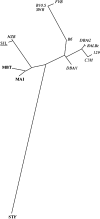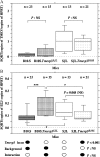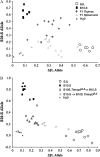Interleukin 22 is a candidate gene for Tmevp3, a locus controlling Theiler's virus-induced neurological diseases
- PMID: 17483407
- PMCID: PMC1931528
- DOI: 10.1534/genetics.107.073536
Interleukin 22 is a candidate gene for Tmevp3, a locus controlling Theiler's virus-induced neurological diseases
Abstract
After intracerebral inoculation, Theiler's virus induces in its natural host, the mouse, an acute encephalomyelitis followed, in susceptible animals, by chronic inflammation and primary demyelination. Susceptibility to demyelination among strains of laboratory mice is explained by the capacity of the immune system to control viral load during persistence. Also, differences of susceptibility to viral load between the susceptible SJL strain and the resistant B10.S strain are mainly due to two loci, Tmevp2 and Tmevp3, located close to the Ifng locus on chromosome 10. In this article, we show that the Tmevp3 locus controls both mortality during the acute encephalomyelitis and viral load during persistence. Most probably, two genes located in the Tmevp3 interval control these two different phenotypes with efficiencies that depend on the age of the mouse at inoculation. Il22, a member of the IL-10 cytokine family, is a candidate gene for the control of mortality during the acute encephalomyelitis.
Figures






Similar articles
-
Two loci, Tmevp2 and Tmevp3, located on the telomeric region of chromosome 10, control the persistence of Theiler's virus in the central nervous system of mice.Genetics. 1999 May;152(1):385-92. doi: 10.1093/genetics/152.1.385. Genetics. 1999. PMID: 10224268 Free PMC article.
-
Genetics of susceptibility to Theiler's virus infection.Bioessays. 1998 Aug;20(8):627-33. doi: 10.1002/(SICI)1521-1878(199808)20:8<627::AID-BIES5>3.0.CO;2-F. Bioessays. 1998. PMID: 9780837 Review.
-
The Th1/Th2 balance does not account for the difference of susceptibility of mouse strains to Theiler's virus persistent infection.J Immunol. 1999 Jun 15;162(12):7330-4. J Immunol. 1999. PMID: 10358183
-
Tmevpg1, a candidate gene for the control of Theiler's virus persistence, could be implicated in the regulation of gamma interferon.J Virol. 2003 May;77(10):5632-8. doi: 10.1128/jvi.77.10.5632-5638.2003. J Virol. 2003. PMID: 12719555 Free PMC article.
-
The genetics of the persistent infection and demyelinating disease caused by Theiler's virus.Annu Rev Microbiol. 2005;59:279-98. doi: 10.1146/annurev.micro.59.030804.121242. Annu Rev Microbiol. 2005. PMID: 16153171 Review.
Cited by
-
Interleukin-22 is increased in multiple sclerosis patients and targets astrocytes.J Neuroinflammation. 2015 Jun 16;12:119. doi: 10.1186/s12974-015-0335-3. J Neuroinflammation. 2015. PMID: 26077779 Free PMC article.
-
Invariant NKT cells regulate the CD8 T cell response during Theiler's virus infection.PLoS One. 2014 Jan 30;9(1):e87717. doi: 10.1371/journal.pone.0087717. eCollection 2014. PLoS One. 2014. PMID: 24498175 Free PMC article.
-
Host genetic background influences diverse neurological responses to viral infection in mice.Sci Rep. 2017 Sep 22;7(1):12194. doi: 10.1038/s41598-017-12477-2. Sci Rep. 2017. PMID: 28939838 Free PMC article.
-
Restraint stress modulates virus specific adaptive immunity during acute Theiler's virus infection.Brain Behav Immun. 2009 Aug;23(6):830-43. doi: 10.1016/j.bbi.2009.03.010. Epub 2009 Apr 5. Brain Behav Immun. 2009. PMID: 19348911 Free PMC article.
-
Upregulation of Inflammatory Mediators in Peripheral Blood CD40+ Cells in Children with Autism Spectrum Disorder.Int J Mol Sci. 2023 Apr 19;24(8):7475. doi: 10.3390/ijms24087475. Int J Mol Sci. 2023. PMID: 37108638 Free PMC article.
References
-
- Adkins, B., C. Leclerc and S. Marshall-Clarke, 2004. Neonatal adaptative immunity comes of age. Nat Rev. Immunol. 4: 553–563. - PubMed
Publication types
MeSH terms
Substances
LinkOut - more resources
Full Text Sources
Other Literature Sources
Molecular Biology Databases

